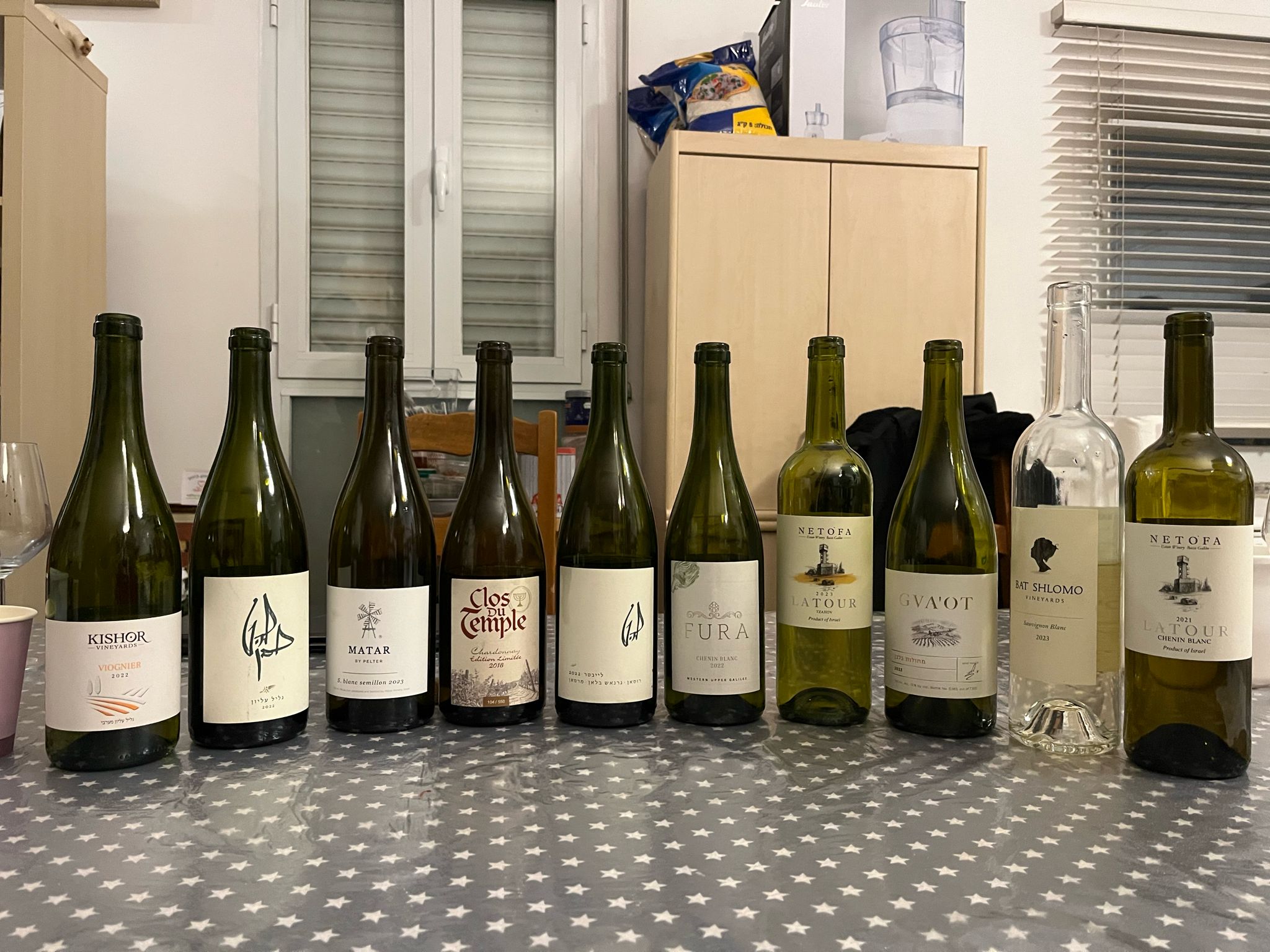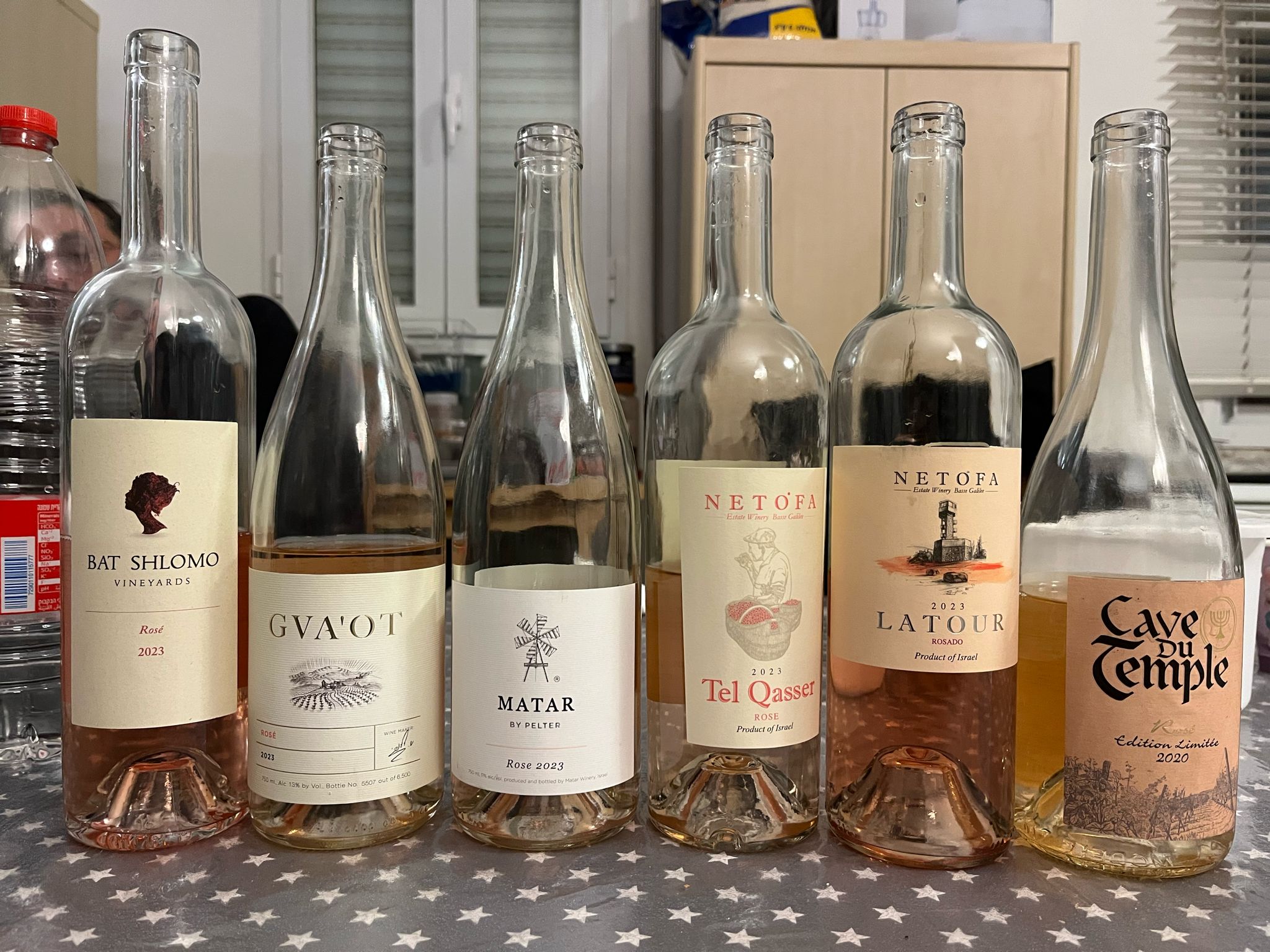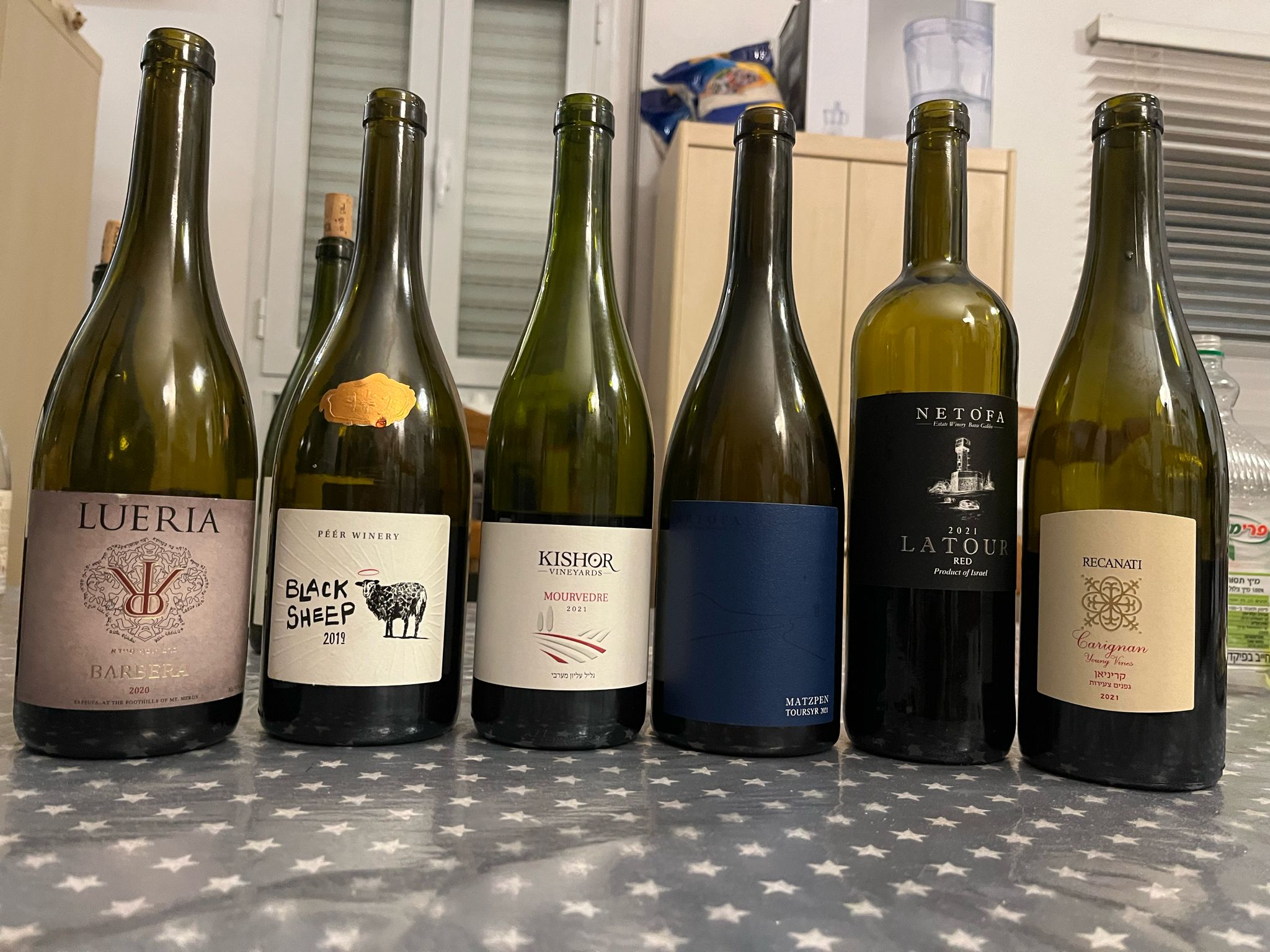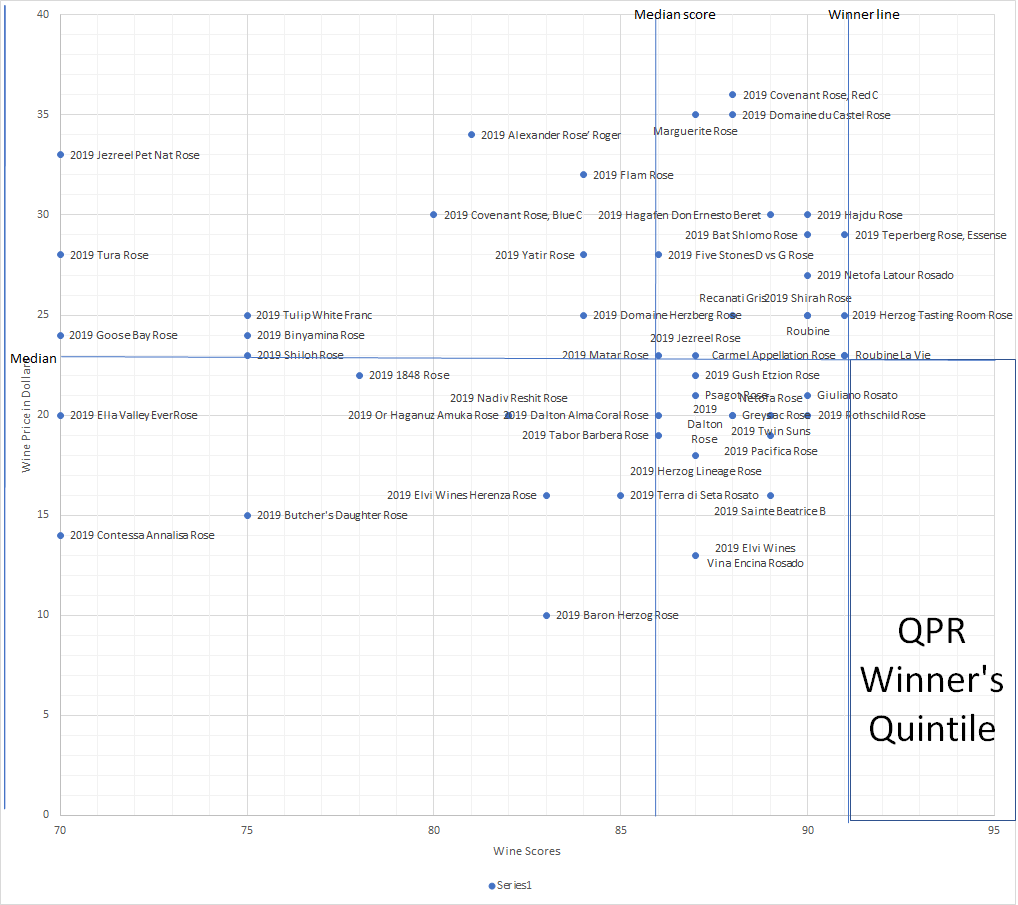Blog Archives
The 2021 Kosher rose season is open and I am still underwhelmed – scene 3
I know some of you are hoping for posts from my trip to France. However, I need to clean-up some missing posts, I have a lot of wine that needed to be posted and now I will do those quickly. After that I will start posting the wines I tasted in France.
So, the last time I posted about roses, we had the lovely 2020 Chateau Sainte Marguerite Rose and the 2020 Chateau Sainte Marguerite, Cuvee Fantastique Rose, and I also tasted a few roses before my trip to Paris.
I will not repost all my thoughts on roses and the such or how they are made, please read my last post for all of that information.
This will be a quick and simple post for the roses I had not yet posted to the blog.
Best rose so far in 2021
Well, let’s hold up here for a second. as stated above, I have not tasted all the roses out there yet. I will get more over the next couple of weeks. I will probably taste as many as I did last year, again given the logistics of life today. That will still be fewer than in 2019.
If there are two ideas you get from this post that would be great. ONE: Drink only 2020 roses now. TWO: Drink refreshing roses. A rose that feels heavy, unbalanced, and one that does not make you reach for more, is not a rose I would recommend.
So with that said, here are the best options, if you must have a rose, sadly only a couple of these are worth buying – but so far are the best options here in the USA:
- 2020 Chateau Sainte Marguerite Cuvee Fantastique Rose – best rose I have tasted so far, but not including roses I had in France
- 2020 Or Or de la Castinelle Rose and the 2020 Domaine du Vallon Des Glauges Rose – ONLY QPR WINNERS
- 2020 Cantina Giuliano Rosato – a fun wine at a great price
- 2020 Sainte Beatrice B – is the best of the European Mevushal Rose, with the Roubine a touch behind
- 2020 Hajdu Rose – is the best of the Cali roses (that I have tasted so far)
- 2020 Domaine Netofa Rose/2020 Dalton Rose – nicest of the riper roses (that I have tasted so far)
- 2020 Lahat Vignette Rose – is the best of the Israeli rose, but expensive
The wine notes follow below – the explanation of my “scores” can be found here and the explanation for QPR scores can be found here:
2020 Domaine du Vallon Des Glauges Rose – Score: 91 (QPR: WINNER)
This is the second rose that is a WINNER – BRAVO! This wine is a blend of 60% Grenache and 40% Counoise, yes you had me at Counoise! Interestingly, comparing the Sancerre Rose to this one, the Sancerre is riper and the Vallon is dry as all dry, it is bone dry, and it is very different. To double down on my previous statement this is not your strawberry, raspberry, cherry wine, this is more white fruit than red fruit. The nose on this wine is unique and lovely, with notes of tart strawberry, peach, apricot, jasmine, flint, smoke, and rocks galore – lovely! The mouth on this medium-bodied wine is so refreshing, so lovely, so fun, so invigorating, I could not spit this one, with rich saline, plus acidity, funk galore, peach, tart red fruit, pear, and intense grapefruit/lime. The finish is so long, so lovely, balanced, refreshing, it pulls you in with pith, fruit, mineral, limestone, slate, and rock. WOW! Drink now. (tasted May 2021)
2020 J. De Villebois Sancerre Rose (M) – Score: 90 (QPR: GOOD)
I had heard rumors about thsi wine but they were all wrong – this is a lovely wine! The nose on this Pinot Noir Rose, is crazy fun, with intense mineral, loads of tart strawberry, rosewater, cherry, flint, limestone, and lovely floral rose petals. The mouth on this medium-bodied rose is screaming with acid, the acid hits you and it never leaves, but it is not a one-trick pony, the wine is balanced with ripe fruit, strawberry, peach, lavender, watermelon, intense mineral, more of the limestone, slate, and smoke, with rich saline, pink grapefruit, and intense acid that goes on forever. This wine is super refreshing, tart, fruity, balanced, and really fun, Nice!! (tasted May 2021)
2020 Herzog Limited Edition Rose of Pinot Noir, Tasting Room – Score: 90 (QPR: EVEN)
The nose on this wine is sweet, with intense floral notes, candied fruit, and rich mineral. The mouth on this medium-bodied wine is solid, with intense rhubarb, pomegranate, and strawberry, with enough acid, nice rosehip, sweet fruit, and berries. The finish is long, tart, sweet, and ripe but balanced, nice! Drink now. (tasted April 2021)
2020 Bat Shlomo Rose – Score: 89 (QPR: EVEN)
The wine has enough here to make me interested but in the end it comes up short. The nose on this wine is nice with the smoke and flint, that is the best part, sadly, after that, there is little to captivate you, strawberry, raspberry, and lime are also present. The mouth on this medium-bodied wine feels a bit hollow, it has the acid, it feels correct, it has some amount of refreshment, but the hole in the middle is maddening, with good acid in the front and back, strawberry, lime, tart quince, Rooibos notes, and lingering acidity on the end. a nice enough wine drink now. (tasted May 2021)
2020 Rubis Roc Rose (M) – Score: 88 (QPR: GREAT)
This wine is a blend of 50% Cinsault and 50% Cabernet Sauvignon. This is a nice enough rose, it lacks the acid punch I crave but it has some bite. The nose on this wine is muted, with notes of funk, cherry, raspberry, plum, and flint. The mouth of this medium-bodied wine is balanced but it lacks the acid, it has the fruit, and it is refreshing, but what it needs is more punch and more bite. Still, a nice enough rose. Drink now. (tasted May 2021)
2020 Shirah Rose – Score: 85 (QPR: EVEN)
The nose on this wine is ripe, showing notes of candied fruit, watermelon, pomegranate, rosewater, orange blossom, red fruit, and spices. The mouth on this wine is empty, it has fruit, ripe fruit, and some mineral, but there is no acidity, it is flat, it has enough fruit to make things interesting, with ripe and candied plum, strawberry, rosewater, and sweet spices, but it truly lacks acid and lacks the refreshing factor. Drink now. (tasted May 2021)
2020 The Butcher’s Daughter South Rose (M) – Score: 80 (QPR: NA)
This wine is a blend of 60% Cinsault and 40% Cabernet Franc. The nose on this wine is is muted and flat much like this wine, though there is acidity in the mouth the rest is hollow and empty. The mouth on this wine is flat as well and has acid, raspberry, and cooked fruit to show. Drink now. (tasted May 2021)
2020 Tura Mountain Vista Rose – Score: 70 (QPR: BAD)
This wine is a blend of 68% Merlot and 32% Cabernet Sauvignon. I keep asking for wineries, to be honest, if a wine has residual sugar why are you writing the wine is dry? This is not a dry wine by anyone’s assessment. The nose on this wine is ripe, candied watermelon, lifesaver candy, and loads of ripe peach, pineapple, and candied fruit, with a hint or two of floral notes and that, is it. The mouth on this wine, to me, is appalling, it is 100% in-your-face fruit, no attempt to show balance, just candy and more candy, think of Halloween night and you are 7 years old, that is what this tastes like. This is all Jolly Rancher sweet, with watermelon, peach, pineapple, and just no balance. Sad. Drink now. (tasted May 2021)
The 2019 Kosher rose season is open but I am underwhelmed at best
It is not yet summer and here in NorCal, it feels more like winter with these strange May storms with thunder and hail. Sorry, but in NorCal, we do not get thunder, it is very strange indeed! Anyway, enough with my meteorologist fanboy moment, the weather was not conducive for my last tasting here in San Jose with a group of folks, but Rose was on the docket so rose it was.
Rose wine in the non-kosher market is exploding – especially Rose wine from Provence; a wine region of France. Sadly, in the kosher wine market – that is not quite the case. I did not stress my previous statement with a suffix of AT ALL, even though I am not allowed to open a bottle of rose on my Shabbos table with guests – why? Well, that is simple – no one will drink it!!
Even worse, is that wine manufacturers may well have jumped the shark! There will be some 60+ kosher roses available in the USA this year! That may not sound like a lot, but when all you had was Herzog White Zinfandel 10 years ago – it is insane. The first high-end rose was Castel’s 2009 rose and that was only 10 years ago. Back then, there were few to no real Rose wine options, other than a handful of Israeli wines and almost no French Rose made it here. Now we will have tons of Rose, and I really think the real question here is will people drink it all?
Also, I want to bring up a topic I rarely talk about – price! Yeah, I hear you, Avi Davidowitz, of KosherWineUnfiltered, please quiet down, gloating does not suit you – (smiley face inserted here). The prices of Rose wines have gotten out of control. QPR (Quality to Price Ratio) has become nonexistent, essentially here in the USA, for the kosher rose market. Finally, I am sorry, but I really feel that wineries were either horribly hampered in some way with the 2018 rose vintage, or honestly, they just threw in the towel, The 2018 vintage is the worst one in the last 10 years. We have hit Peak Rose, we really have. Peak X is when X becomes so default within the construct of our lives, and the quality and quantity of X peaks. Clearly, calling peak kosher rose is a subjective call, but look around. The roses of 2018 feel commodity at best, they feel rushed, no real care, rhyme, or reason. They feel like we have peaked. They are nowhere near 2017, and 2017 was nowhere near 2016, and so on. I am sure next year may be another peak rose, and to be honest, many have called for Peak Oil and Peak TV, so maybe I am just projecting what I see around me, but this year’s crop of roses feel half-hearted pure cash cows, and really without love behind them.
As always, I will be chastised for my opinions, my pronouncements, and I am fine with that. This is wakeup post, there may be ONE or two roses I would buy, but respectfully, given the prices, I would rather buy, the 2018 Covenant Sauvignon Blanc, 2017 O’dwyers Sauvignon Blanc, the 2018 Goose Bay Sauvignon Blanc, and so on. Throw in the 2018 Tabor Sauvignon Blanc and the 2018 Or Haganuz Amuka Blanc Blend, and really who cares about a rose?
I was thinking about going with the title: 2018 kosher roses, thanks, but who cares? Because that is how I feel. This vintage is a massive letdown, prices are too high, quality has hit rock bottom, and overall professionalism, IMHO, has gone along with the quality. Wineries have been getting away with less and less quality for years, raising prices, and this is the worst I have seen in the rose market overall. So, yeah, who cares?
Wine Color
What is rose wine? Well, simply said, a rose is a wine that can best be defined as the wine world’s chameleon. Where white wine is a pretty simple concept – take white grapes, squeeze them, and you get clear to green colored juice. Yes, the white grape juice is clear – well so is red grape juice, but more on that in a bit. Read the rest of this entry
The 2018 Kosher rose season is open – part 3
Well, after the first post I stated that I would be doing this rose wine post a few times. The subsequent posts would have the original content, and the newly revised or added rose wines as well. Well, this is part 3, and I hope this is the last one! My schedule was insane, but it is now slowing down, thankfully, so I hope to be adding more posts as well!
It is still officially Summer, which means it is Rose time! Rose wine in the non-kosher market is exploding – especially Rose wine from Provence; a wine region of France. Sadly, in the kosher wine market – that is not quite the case. I did not stress my previous statement with a suffix of AT ALL, even though I am not allowed to open a bottle of rose on my Shabbos table with guests – why? Well, that is simple – no one will drink it!!
Even worse, is that wine manufacturers may well have jumped the shark! There will be some 50 dry-ish kosher roses available in the USA this year! That may not sound like a lot, but when all you had was Herzog White Zinfandel 10 years ago – it is insane. The first high-end rose was Castel’s 2009 rose and that was only 9 years ago. Back then, there were few to no real Rose wine options, other than a handful of Israeli wines and almost no French Rose made it here. Now we will have tons of Rose, and I really think the real question here is will people drink it all?
Wine Color
What is a rose wine? Well, simply said, a rose is a wine that can best be defined as the wine world’s chameleon. Where white wine is a pretty simple concept – take white grapes, squeeze them, and you get clear to green colored juice. Yes, the white grape juice is clear – well so is red grape juice, but more on that in a bit.
White wine is not about color – almost all color in a white wine comes from some oak influence of some sort. So, an unoaked Sauvignon Blanc or Pinot Gris can sometimes look almost clear, depending on the region and how the wine was handled. Now oaked Chardonnay, of course, is what most people use as an example of a dark white wine. As the Wine Folly linked above states, different wine regions oak their Chardonnay differently and as such, they are sold with different hues from the start. With age, the wine changes color and the light gold moves to darker gold shades.
The only real exception to the stated rule above – that white grape juice without the influence of oak is somewhere in the clear to green color spectrum, is – orange wines. We have spoken about orange wines – mostly thanks to Yaacov Oryah. Outside of Yaacov’s work there really is no orange wine in the kosher world to speak about. Orange wine is made exactly like red wine, which means that the clear grape juice is left to sit on the yellowish to dark yellow grape skins (depending upon what varietal is used to make the orange wine).
Red wine juice – straight from the grape comes out the same color as white grapes. You see the juice from grapes is mostly clear to greenish in color. The red wine color comes from macerating the juice on the grape skins. The longer the juice sits on the grape skins (wine must) the redder in color the wine becomes until it reaches its maximum red color potential.
The only real exception to the rule of a grape’s juice color is the Teinturier varieties. The grapes are called Teinturier, a French language term meaning to dye or stain. The list of grapes whose juice is actually red colored is long – but the list of kosher wine options that is a wine made from these grapes – is the Herzog Alicante Bouschet. The Gamay de Bouze is not a normal Gamay grape, it is one of those grape mutations that are very red in nature. Read the rest of this entry
The 2018 Kosher rose season is open – part 2
Well, after the first post I stated that I would be doing this rose wine post a few times. The subsequent posts would have the original content, and the newly revised or added rose wines as well. Well, this is part 2, and there will be at least a part 3 or maybe a part 4, such is life. My schedule is insane right now (not complaining in any way), so when I can grab a few moments to update the roses I have had, I take it with both hands!
It is still officially Spring, which means it is Rose time! Rose wine in the non-kosher market is exploding – especially Rose wine from Provence; a wine region of France. Sadly, in the kosher wine market – that is not quite the case. I did not stress my previous statement with a suffix of AT ALL, even though I am not allowed to open a bottle of rose on my Shabbos table with guests – why? Well, that is simple – no one will drink it!!
Even worse, is that wine manufacturers may well have jumped the shark! There will be some 50 dry-ish kosher roses available in the USA this year! That may not sound like a lot, but when all you had was Herzog White Zinfandel 10 years ago – it is insane. The first high-end rose was Castel’s 2009 rose and that was only 9 years ago. Back then, there were few to no real Rose wine options, other than a handful of Israeli wines and almost no French Rose made it here. Now we will have tons of Rose, and I really think the real question here is will people drink it all?
Wine Color
What is a rose wine? Well, simply said, a rose is a wine that can best be defined as the wine world’s chameleon. Where white wine is a pretty simple concept – take white grapes, squeeze them, and you get clear to green colored juice. Yes, the white grape juice is clear – well so is red grape juice, but more on that in a bit.
White wine is not about color – almost all color in a white wine comes from some oak influence of some sort. So, an unoaked Sauvignon Blanc or Pinot Gris can sometimes look almost clear, depending on the region and how the wine was handled. Now oaked Chardonnay, of course, is what most people use as an example of a dark white wine. As the Wine Folly linked above states, different wine regions oak their Chardonnay differently and as such, they are sold with different hues from the start. With age, the wine changes color and the light gold moves to darker gold shades.
The only real exception to the stated rule above – that white grape juice without the influence of oak is somewhere in the clear to green color spectrum, is – orange wines. We have spoken about orange wines – mostly thanks to Yaacov Oryah. Outside of Yaacov’s work there really is no orange wine in the kosher world to speak about. Orange wine is made exactly like red wine, which means that the clear grape juice is left to sit on the yellowish to dark yellow grape skins (depending upon what varietal is used to make the orange wine).
Red wine juice – straight from the grape comes out the same color as white grapes. You see the juice from grapes is mostly clear to greenish in color. The red wine color comes from macerating the juice on the grape skins. The longer the juice sits on the grape skins (wine must) the redder in color the wine becomes until it reaches its maximum red color potential.
The only real exception to the rule of a grape’s juice color is the Teinturier varieties. The grapes are called Teinturier, a French language term meaning to dye or stain. The list of grapes whose juice is actually red colored is long – but the list of kosher wine options that is a wine made from these grapes – is the Herzog Alicante Bouschet. The Gamay de Bouze is not a normal Gamay grape, it is one of those grape mutations that are very red in nature. Read the rest of this entry
The 2018 Kosher rose season is open
It is officially Spring (though it snowed in Chicago for Passover – so I will hold judgment on that fact for a bit), which means it is Rose time! Rose wine in the non-kosher market is exploding – especially Rose wine from Provence; a wine region of France. Sadly, in the kosher wine market – that is not quite the case. I did not stress my previous statement with a suffix of AT ALL, even though I am not allowed to open a bottle of rose on my Shabbos table with guests – why? Well, that is simple – no one will drink it!!
Even worse, is that wine manufacturers may well have jumped the shark! There will be some 50 dry-ish kosher roses available in the USA this year! That may not sound like a lot, but when all you had was Herzog White Zinfandel 10 years ago – it is insane. The first high-end rose was Castel’s 2009 rose and that was only 9 years ago. Back then, there were few to no real Rose wine options, other than a handful of Israeli wines and almost no French Rose made it here. Now we will have tons of Rose, and I really think the real question here is will people drink it all?
Wine Color
What is a rose wine? Well, simply said, a rose is a wine that can best be defined as the wine world’s chameleon. Where white wine is a pretty simple concept – take white grapes squeeze them and you get clear to green colored juice. Yes, the white grape juice is clear – well so is red grape juice, but more on that in a bit.
White wine is not about color – almost all color in a white wine comes from some oak influence of some sort. So, an unoaked Sauvignon Blanc or Pinot Gris can sometimes look almost clear, depending on the region and how the wine was handled. Now oaked Chardonnay, of course, is what most people use as an example of a dark white wine. As the Wine Folly linked above states, different wine regions oak their Chardonnay differently and as such, they are sold with different hues from the start. With age, the wine changes color and the light gold moves to darker gold shades.
The only real exception to the stated rule above – that white grape juice without the influence of oak is somewhere in the clear to green color spectrum, is – orange wines. We have spoken about orange wines – mostly thanks to Yaacov Oryah. Outside of Yaacov’s work there really is no orange wine in the kosher world to speak about. Orange wine is made exactly like red wine, which means that the clear grape juice is left to sit on the yellowish to dark yellow grape skins (depending upon what varietal is used to make the orange wine).
Red wine juice – straight from the grape comes out the same color as white grapes. You see the juice from grapes is mostly clear to greenish in color. The red wine color comes from macerating the juice on the grape skins. The longer the juice sits on the grape skins (wine must) the redder in color the wine becomes until it reaches its maximum red color potential.
The only real exception to the rule of a grape’s juice color is the Teinturier varieties. The grapes are called Teinturier, a French language term meaning to dye or stain. The list of grapes whose juice is actually red colored is long – but the list of kosher wine options that is a wine made from these grapes – is the Herzog Alicante Bouschet. The Gamay de Bouze is not a normal Gamay grape, it is one of those grape mutations that are very red in nature. Read the rest of this entry
Kosher Rose wines of 2017 – final take
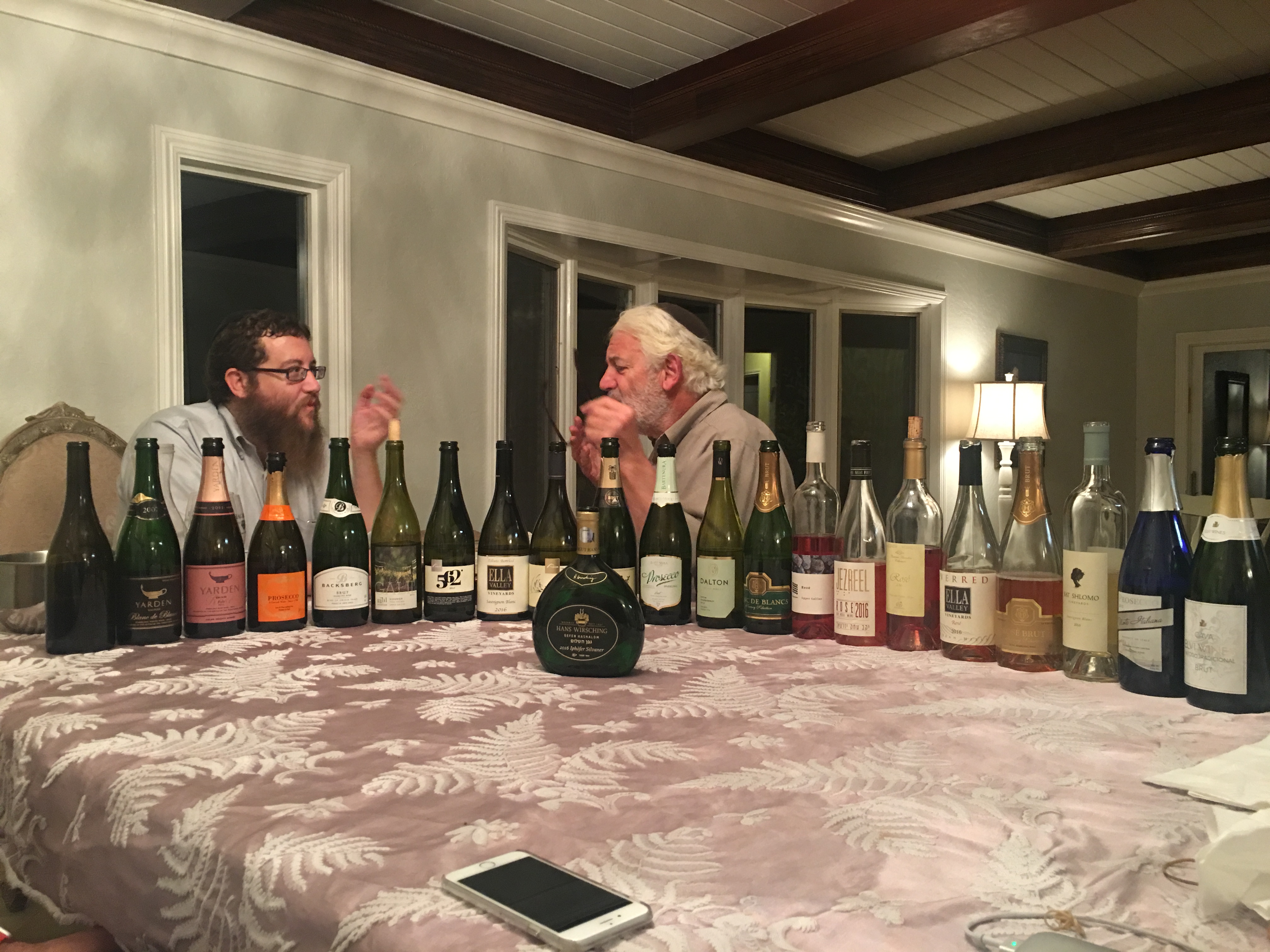
After all the tastings I have had for rose wines this year – I can say for now, that I am as far along as I can go without being in Israel, or asking people to schlep wines for me from Israel. I am still missing the new 2016 Elvi Wines Rose, the 2016 Terra de Seta Rose, the 2016 Matar Rose, and the 2016 Gvaot Rose. I guess that will have to be. When I get to Israel soon enough I will post again, but just on those wines.
In the end, my overall take on Israeli roses this year has been a huge and utter letdown. To me, there are few roses that I would waste my time drinking. In the end, the Netofa, Vitkin, Psagot, and Castel Roses are the only roses that I would buy this year, other than the untasted wines listed above (Matar and Gvaot), which may well be good.
The real saviors for us have indeed been Spain and USA. France has thrown in the La Vie Roubine, but it is not as good as the Ramon Cardova rose.
So, in closing, I will repeat what I listed the last posting. These wines are the best for each category, nothing I tasted in the last tasting has changed much around them, other than the sweet rose entry, which I would never buy, but is useful for those that like rose that way.
So, here are my recommendations based upon the wines I have tasted:
- 2016 Ramon Cardova Rose, is the best rose so far, but it is not a Provence style wine, it is more of a tweener.
- The 2016 Chateau Dubois is the best French rose I have tasted so far, but it is a clear non-Provence style rose.
- 2016 Chateau Roubine la Vie, is the best French classic Provence style rose.
- 2016 Ramon Cardova Rose is the best Spanish rose (that I have had the chance to taste so far, sadly I have yet to taste the new 2016 Elvi Rose)
- The 2016 Shirah Rose is the best USA rose. It is not a Provence style wine, it is a massive wine but a really fun one.
- The 2016 Netofa Rose is the best rose from Israel, it is as close to a Provence style wine I have found so far in Israel. Vitkin is right behind, along with Castel (but it is really expensive for the wine), and Psagot in the bigger/fuller rose category for Israel.
- The 2016 Psagot Rose (when it is on) is the best full bodied rose wine from Israel.
- The best sweet rose that is drinkable is the 2016 Contessa Annalisa Rose. Hopefully, a gateway rose to the drier and better options above.
Rose winemaking approaches
If you read the previous article, you would have read that there are classically three ways to make Rose; Maceration, Saignée, and blend.
The interesting thing we are seeing is a slight variation to the rose making – that is after they make the rose, using any of the aforementioned approaches, they are adding in some white wine! This is straight up genius! Why? Because as explained in the previous post, red grape juice has very few phenolics in it! The real phenolic powerhouse – for red wines, are the skins! White wine does not need skins to give it their phenolics, they have it innately from the juice alone. So, when you take red grapes and essentially crush them and bottle them, with minimal grape contact, what you get is a fun wine, that has very few phenolics in it. So, you have a few options, either let the liquid sit longer on the grape skins, thereby improving the phenolics, but that takes away from the classic rose look, as skin contact turns the juice darker. So, if you want more phenolics and less grape skin contact to keep the classic rose color, you can add in white wine!
The Ramon Cardova is a perfect example of this. As is the Elvi Rose (a wine I have not tasted), and the Jezreel Rose (see below). These three wines all added in different white wines, and it is a clear bump in the correct direction, but to the purists, it is not cool! I cannot speak to the purist’s issues, and yes, I can see that the Cardova is not a classic Provence wine, but it is a very enjoyable summer wine, and in the end, that is what rose to me, is all about!

